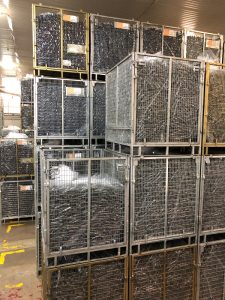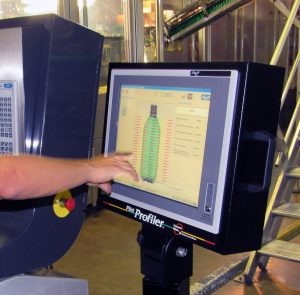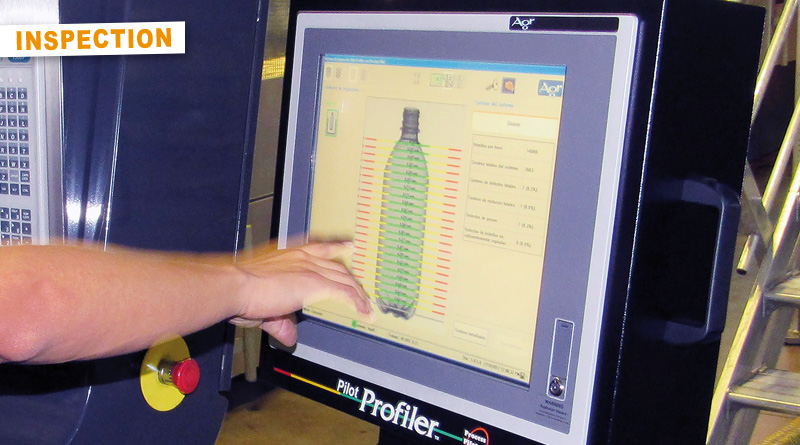A journey into the unknown
Agr helps beverage brand owners manufacturing PET containers
In many beverage plants, the decision to self-manufacture PET bottles is a journey not just into the unknown, but the unknown unknown. Agr’s Process Performance Optimization Group (PPOG) consultants help processors navigate this unfamiliar terrain.
The new millennium has seen tremendous advances in PET bottle blowing technology, from block or integrated blow-fill machines to the breakthrough Process Pilot automated blowmoulder control system introduced by Agr International. At the same time, there’s been an absence of demand growth for carbonated beverages, a consequence of the increasing consumer appetite for a healthier diet as evidenced by tremendous demand growth for bottled water. Several big-name converters have consolidated, changed focus, or exited the business. Not surprisingly, the industry saw a wave of retirements among plastics engineers. All this was unfolding against the backdrop of mounting environmental concerns that prompted fillers to rethink the need to ship empty bottles hundreds of miles to their plants.
The beverage industry responded with a logical solution: bring blowmoulding in-house. The numbers pencil out, and it makes sense from the sustainability perspective. Making bottles on demand at the point of filling also offers the advantages of increased flexibility and closer control. According to Paul DiZinno, Manager of Agr’s Process Performance Optimization Group, brand owners have invested in hundreds of blowmoulding lines over the past decade. The seismic shift to self-manufacturing has spread far beyond the U.S. to beverage operations around the globe. But as one major CSD processor in Germany found out, there’s a lot to learn about the blowmoulding process.
Labeller trouble
Opening in 2018, the German plant was designed and equipped for efficiency and productivity, with the Agr Process Pilot installed inside the 20-mould KHS blow-fill machine. Prior to installation of Agr’s Process Pilot system, container handling issues were observed on the high-speed line producing 42,000 bph. Sometimes, the bottles seemed to wobble in the labeller, as though they weren’t sitting well in the cup. Further downstream, labels would pop off as the containers were going into pallets.
New to blowmoulding, plant personnel didn’t know how to track down the cause of the skewed labels. Nor did they suspect that it was the symptom of a much more significant problem. As a long-term supplier of critical measuring instruments and productivity tools to the plastic packaging industry, Agr was keenly aware of the industry shift to self-manufacturing – and its pitfalls. PET bottle making is extremely sensitive to a host of variables. Dynamics like temperature, humidity, preform composition, machine condition, or even operator skill can impact material distribution, the key factor in bottle performance. Process Pilot takes and analyses real-time measurements of the thickness of the sidewall of every single bottle, then adjusts the blowmoulder control parameters if material distribution starts trending out of spec. The result is an optimised blowing process that ensures consistent container quality and performance.
PPOG supplements Agr’s Process Pilot by providing plants with fundamental process knowledge. Brand owners have discovered a shortage of knowledgeable plastics personnel in the job market. The PPOG engineers, veterans with a long history in bottle manufacturing operations, have deep expertise in the blowmoulding process. They also take a holistic view of the vast chain of interrelationships throughout the production cycle. All these elements must be coordinated to achieve sustainable improvements in stability, uniformity, and productivity.
Turn down the heat

The issue of the wobbling bottles came up when PPOG Process Engineer Consultant Damon Choate was in the German plant for phased commissioning of the Process Pilot. Without on-site equipment to do qualitative bottle testing, Choate sent samples to the Agr service depot in Italy for analysis. There, bottle volume expansion and maximum burst pressure data, provided by Agr’s PPT3000 Packaging Pressure Tester, revealed that the bottles were subject to frequent base stress crack failures. “Half the sample bottles burst in the base just a few seconds into the test,” Choate relates. “The ones that didn’t fail had over 40 per cent volume expansion. The resin wasn’t being distributed properly, which is why the bottles wobbled and didn’t fit in the label cup.” “Agr is well known for our ability to test volume expansion,” DiZinno observes. “We were the first to do the 13-second expansion test. This is the number-one parameter PPOG engineers look at. Even if the weights are exactly centered, we can tell whether the problem resides with the material, the process, or the design.”
With the PPT results indicating room for improvement in the process, the engineers reviewed the bottle recipe, or blowmoulder settings. It was clear to them that too many oven lamps were directed to turn on during blowing. The process was running too hot, and the preform temperature was higher than necessary to produce the ideal stretch and orientation of the PET molecules. “In general, when making PET bottles, the colder you can make the process, the better,” explains Choate. “The goal in blowing is to get the very best orientation of the PET, both vertically and horizontally. This gives the best container strength.”
It’s true that high heat makes the PET more pliable and easier to stretch, but all stretching is not equal, he points out. Cold forces the molecules to align better vertically and horizontally. Reducing the preform temperature specified in the recipe by a few degrees will produce better overall resin distribution and better strength and rigidity, a critical attribute for shelf life. Gas permeation through the walls and resistance to volume expansion also improve with the proper orientation of molecules in a colder blow.
In all, the PPOG engineers reduced the number of lamps that turned on in the oven by 15, from 69 from the original recipe to 54 in the revised one. They also lowered the preform temperature setpoint by four degrees. With these two changes, the bottle volume expansion went down to the most desirable rate of 12 to 13 per cent, from 40 per cent prior to the engagement, “a vast improvement,” DiZinno notes. Additionally, while it wasn’t a goal at the outset, the significant reduction in the blowmoulder operating temperature generated approximately $20,000 in annual energy savings.
Adressing the variables
While the preform temperature inside the blowmoulder was the chief cause of non-conforming bottles for the German drinks maker, in other cases the PPOG engineers often connect the dots back to a processor’s preform supply. In fact, one of the most common challenges to optimum blowmoulder performance is the lack of consistency in preforms. Given that blowmoulding is a process where uniformity is key to stability, preform variations can produce out-of-spec bottles that seriously disrupt downstream production. Especially with today’s ultra-high line speeds, just a few minutes of downtime can cause a processor to lose thousands of dollars in sellable goods.

Preform variations have multiple root causes. Without strict inventory control, they can age in storage and absorb moisture, or batches can become mixed. Preform age is a major source of variation. Further up the supply chain, preform manufacturers might switch to a different resin composition or use different injection moulding machines to fill a single customer order. “Self-manufacturers aren’t always tuned in to the subtle differences in product from their suppliers, and those differences can impact the entire filling line,” DiZinno comments.
As an example, he cites one plant that was having trouble with non-conforming bottles. There were multiple issues with poor bottle handling due to the preform variability causing unplanned stops, and jams in the filler, labeller, and bundler. After investigating, DiZinno found that the plant was receiving preforms made from two different resins on 10 different injection machines at five different facilities within the organisation. “The operators were making a single bottle design on a dedicated blowmoulder, but they needed 33 different recipes to accommodate the different preforms. There was so much variability in their process, they tried to compensate by fine-tuning a recipe for each different combination,” he relates. “The plethora of recipes just multiplies the opportunities for errors, and in the end, the bottles were never ideal.”
To help plant personnel understand what was happening, DiZinno called up a production history chart on the Process Pilot screen to illustrate in granular detail how the thickness of the bottle sidewall jumped for 25 minutes when correlated with a specific preform batch. He explained how to interpret the data, showing operators how to use that detailed insight into thickness distribution to learn how to make better performing bottles. After assisting the customer with optimising its process and engaging Process Pilot, the plant was able to handle all its preform sources with a single recipe.
Lightweight and rPET
That knowledge will be of increasing value as sustainability continues to grow in importance and brand owners embark on lightweighting and rPET initiatives. While global water brand owners have already made dramatic strides in reducing bottle weights, CSD applications are just beginning to see weight reduction initiatives, Choate reports. Similarly, the commitment from major beverage producers to increase the use of rPET poses additional manufacturing challenges.
“When you use recycled resin, the material in the preform is inconsistent, and the bottle becomes increasingly difficult to make,” DiZinno remarks. “Operators typically don’t have the experience to deal with the issues that can occur.”
Because Agr is not affiliated with any specific blowmoulder manufacturer, the engineers can provide whole-plant assistance even in facilities where multiple blowmoulder brands are running. The PPOG engineers utilising Process Pilot have achieved a gamut of improvements that range from faster blowmoulder start-ups, shorter changeovers, less operator involvement, rapid jam recovery, and reduced scrap to improved bottle quality, lower material consumption, better performance in transit, enhanced shelf appeal, and fewer consumer complaints.
“There will always be a bit of an art to manufacturing preforms and containers,” DiZinno observes. “Our engineers help operators develop a balanced, centered process that allows continuous operation without slowdowns or jamming despite changes like an increase in temperature or the amount of rPET in the preforms. It’s a matter of finding the right recipe for the plant, based on the unique environment. It’s very custom work,” he concludes.

